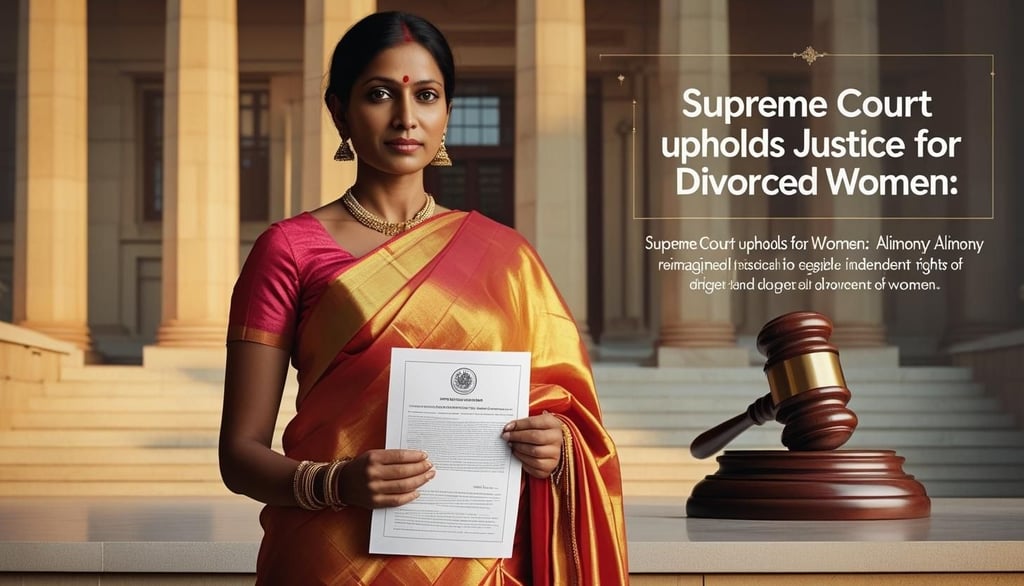⚖️ Supreme Court Enhances Permanent Alimony: Justice for Divorced Wife in Long-Running Matrimonial Case
In a landmark judgment (Rakhi Sadhukhan v. Raja Sadhukhan), the Supreme Court increased permanent alimony to ₹50,000/month, with a 5% hike every 2 years.
ADV NADEEM SAIFI | PARTNER | ALTIUS ASTRA ATTORNEYS
6/16/20252 min read


In a significant judgment delivered on May 29, 2025, the Supreme Court of India revised the permanent alimony awarded to a woman after divorce, setting a key precedent for women's financial rights in matrimonial disputes.
The Court increased the monthly maintenance for Rakhi Sadhukhan, the ex-wife, from ₹20,000 to ₹50,000, citing her long-term financial dependency and the lifestyle she was accustomed to during marriage. The decision highlights the judiciary’s growing emphasis on equitable maintenance for women under the Special Marriage Act and the evolving understanding of post-divorce financial security.
Case Background:
The couple, Rakhi Sadhukhan and Raja Sadhukhan, were married in 1997 and had a son in 1998.
In 2008, the husband filed for divorce under Section 27 of the Special Marriage Act, 1954, alleging cruelty.
Over the years, the wife filed for interim maintenance and permanent maintenance under multiple legal provisions, including Section 125 of CrPC and the Hindu Marriage Act, 1955.
In 2019, the Calcutta High Court granted divorce on grounds of mental cruelty and irretrievable breakdown of marriage and fixed alimony at ₹20,000/month.
Wife’s Appeal to the Supreme Court:
Dissatisfied with the alimony amount, the wife approached the Supreme Court, arguing:
₹20,000/month was originally interim maintenance, not enough for her to maintain a dignified standard of living.
Her former husband had a net monthly income of around ₹4,00,000, indicating his ability to pay more.
She remained unmarried, was financially dependent, and deserved a more realistic and fair amount.
Supreme Court’s Key Observations:
Lifestyle Matters: The Court noted that maintenance should reflect the standard of living enjoyed during marriage.
Husband’s Income Considered: Despite showing a current net salary of ₹1.64 lakh, past income records proved he had the capacity to pay more.
Inflation & Independent Living: Rising costs and the wife's financial independence were important factors in deciding a reasonable sum.
Final Judgment:
Alimony fixed at ₹50,000/month, with 5% increase every two years.
No further maintenance for the son (now aged 26), though the father may voluntarily assist with future education or reasonable needs.
The son's inheritance rights remain unaffected.
Legal Takeaways:
Courts are now considering inflation, actual earnings, and standard of living when deciding alimony.
Women’s financial rights post-divorce are being strongly upheld to ensure they do not suffer unfair hardship.
Proper documentation of income and expenses is critical in alimony cases.
Irretrievable breakdown of marriage continues to be recognized as valid ground for divorce, along with mental cruelty.
Conclusion:
This verdict strengthens the position of divorced women seeking fair and reasonable maintenance. It reinforces the principle that maintenance is not charity—it’s a legal right, especially when the wife has been financially dependent for decades.
Altius Astra Attorneys
A premier law firm based in Delhi, India, offering legal representation across various practice areas for citizens rights and interests.
© 2025. Altius Astra Attorneys. All rights reserved.
Contact Us
📞 9899290789, 9818786756
📧 contact@altiusastra.com
3C-ED Block, Madhuban Chowk, Pitampura, Delhi-110034
DISCLAIMER
